I love picture books.
I am ride-or-die for, e.g., Brundibar, and The Snowy Day, and Elsie Piddock Skips in Her Sleep, and The Very Persistent Gappers of Frip.
I’m also a picture-book hater. Put bluntly, there are a lot of wack illustrators out there, who appear to be mainlining AI and cloying animatronic cutesiness and calling it a style. That is not style! That is not art!
But the illustrators who are killin’ it right now are doing stuff as beautiful and exciting to me as anything happening in Official Grownup Art World. One of them is Estee Zales, who my BAAW found online and sent to me as an example of someone doing gorgeous work that sometimes lands in picture-book territory. We struck up a correspondence, and I’m delighted to share our Q&A.
Please welcome Estee Zales!
What are you working on now?
Personal projects, two commissions, and I'm trying to make my Etsy shop profitable in a way that doesn't hollow me out completely.
You wrote about this in a very funny and affecting way on your Substack:
Since I started making things every day, I've forgotten what it feels like to be normal. Each morning I wake up and think: today I will have to survive myself again. Then I opened an online shop. People buy things. It’s beautiful and scary. Running a shop is like adopting a very expensive pet that hates you. It needs constant attention and gives nothing back except occasional tiny moments of joy that make you forget how awful it is the rest of the time. I love it anyway.
"A very expensive pet that hates you" (!!!). I imagine that every working artist has at some point (or, like, every single day) felt this about the biz side of art—veering wildly between the delight of having people connect with your work and then the demoralizing/odious/annoying tedium of selling and logistics. Can you say more about what this looks like on a day-to-day basis? Where does the awfulness reside, specifically, for you? What do those tiny moments of joy look like? How much time are you spending emailing vs. managing the look of things vs. overseeing packaging and mailing? Do you do the latter yourself from Madrid? How does all that work?
I spend a lot of time replying to emails. It’s not ideal, but I try to remind myself that it means I’m working, and work means money, and money means I get to keep making art.
Starting the online shop was honestly overwhelming. There’s so much no one prepares you for. I’m actually planning to write a full Substack post about it soon, because the amount of behind-the-scenes work is kind of wild. You don’t just make the artwork, you have to learn how to print it properly (oh, you need a special printer, of course), cut it to size, package it so it doesn’t get ruined in the mail… It’s a lot of trial and error. Before all this, I had no experience with any of it. I was just making the art. Suddenly I’m learning how to operate a guillotine cutter like a print shop owner; figuring out shipping labels and customs forms... I do everything myself, with some emotional support from my partner, which honestly goes a long way.
I don’t have a fixed routine. It really depends on what’s going on: orders, deadlines, my mood, my mental health. But I do try to draw something every day, even if it’s just a doodle in my journal.
And then there’s the pressure of Instagram. It’s constant. If I don’t have something “Instagram-worthy,” I start feeling this internal pressure to produce something just to post. It becomes less about creating and more about performing creativity, which can be exhausting. I’m trying to push back against that, to remind myself that I’m a human artist first, not a content machine.
How do money and commerce intersect with your art or craft?
Money makes art possible. Art makes money possible. The circle never stops spinning, and I'm somewhere inside it, trying not to get dizzy.
How do you pay the bills?
By working all the time, taking on multiple projects at once, and selling my art.
Do you have a side hustle? What and why, and is it worth it?
Everything I do feels like a side hustle to some other, more important thing I'm not doing. But my Etsy shop is technically the side hustle. It's worth it in the way that slow, strange things with unclear futures can be worth it. There might be an online teaching thing happening soon.
What's a good month for you in terms of projects and freelance jobs? Could be time spent, money earned, whatever.
When I feel like I’ve managed to balance the work I have to do with the work I want to do. It’s when I end the month and realize I’ve made money, but also had enough time to do something like wander around a bookstore for an hour or get lost in a new idea. I like a month where it doesn’t all feel like hustle, where I can still make art without feeling like I'm constantly chasing it. If I can pull that off? That’s a win.
Do you have a financial advisor of any kind? Why or why not? If yes, how has it worked out?
I have a financial advisor/accountant because I’m not good with numbers. Being a freelancer in Spain is complicated, and I don’t trust myself to navigate it on my own.
I’m Spanish, and even as a local, the freelance system here is confusing and expensive. I lived abroad for a few years, but recently moved back to Spain with my partner, and we both freelance. The system isn’t built for people with irregular income. You have to pay a monthly fee just to be self-employed, regardless of how much you earn, and then deal with quarterly taxes and mountains of paperwork.
We both had to hire accountants because it’s just too complicated to manage ourselves.
Most of our clients are from outside Spain, and that adds another layer of bureaucracy: extra paperwork, different tax rules, and a lot of explaining. It's time-consuming and often frustrating, especially when all you want to do is focus on the work.
What’s your favorite thing to spend money on?
Books. I can never have too many. And art supplies, of course.
Book recs, please! Or what are some books you have read recently? Similarly, when you go to the art store, where do you find yourself lingering longest? What are some tools and materials and supplies you use most and recommend most highly?
Some favorites: Pilgrim at Tinker Creek by Annie Dillard (I keep coming back to it), The Copenhagen Trilogy by Tove Ditlevsen, A House in Norway by Vigdis Hjorth, The Theory of Light and Matter by Andrew Porter, Self-Help by Lorrie Moore, Moon Palace by Paul Auster, The Cost of Living by Deborah Levy, and When We Cease to Understand the World by Benjamín Labatut. I tend to read a mix of fiction, memoir, and slightly existential science writing.
And then of course, art supplies. I’m a sucker for weird pencils, strange crayons, anything with unusual textures. I always find myself lingering in the sections with dry media: pastels, colored pencils, graphite sets I absolutely do not need but somehow convince myself I’ll use. I also hoard different types of paper. I think I love materials that surprise me a little, ones that behave differently depending on how you use them. My recommendations are less about brands and more about exploring. If something looks odd or impractical, I probably want it.
What do you hate spending money on?
Clothes. I wish we could just wear uniforms... so much mental energy wasted on choosing outfits. It’s exhausting.
What is a small purchase (under $20) that gives you great satisfaction and which you would recommend to us?
Some Substacks I really like:
Carson Ellis (Slowpoke)
Allie Sullberg (The Museum of Small and Important Things)
Mekenna Malan (Highway Noise)
Carolyn Yoo (SEE YOU)
Patreon: Rebecca Green, Natalie Andrewson and Carlos TV
I also really love a good literary journal. Granta and Literary Hub are classics, and Poetry Magazine always surprises me. For something more illustration-focused (especially for kids), I really recommend ILLUSTORIA.
Working artists are so often faced with intense precarity at many points in their lives. What, if any, hedges against precarity have you developed?
My partner is an artist too. We understand the weirdness, the chaos, the constant juggling. We navigate it together, which helps. But your 20s as an artist? It’s tough. There’s no way around that. You just sort of… learn how to survive it, or at least, keep going.
What is something you are saving for or want to save for?
A house with a big studio (and maybe a future child).
Artist studios are so dreamy to me. Is this something that visual artists do—dream about the perfect studio? Find pictures of other people's perfect studios online to envy? I'll play that game! What's your perfect studio look like?
There’s this amazing movie called Arrival where Amy Adams plays the lead, and every time I watch it, I get distracted by her house. It’s not an artist studio or anything like that, but the space, open, surrounded by nature, makes me think: that would be the perfect place to create. So yes, I’m saving for a house like that. Maybe one day.
[Estee sent some pictures from the movie, and they are indeed dreamy, but they triggered the “email length limit” from Substack, so I had to cut them. But go look them up! —Ed.]
What is a (happy, sad, painful, funny) childhood memory you have of money or class?
I went to school with wealthy kids and noticed something strange: money seemed to have a way of dulling their creativity. They didn’t need to be resourceful, or come up with wild ideas like the rest of us. Money can either open doors or close them, depending on how it’s used.
In a single word or phrase, how would you describe your relationship with money?
Traumatic.
How much did your family of origin shape that relationship?
I absorbed my parents' anxiety through economic crisis after crisis. It was like background radiation, invisible but altering everything.
If you could wave a magic wand and change one small thing about how our current economic system works, what would you change?
I’d make the financial support for creative work more accessible and less conditional. Right now, artists need to jump through a million hoops to be taken seriously or supported. If we could have a system where creativity didn’t have to be tied to immediate commercial success or “marketability,” it would free up so much potential. Art shouldn’t only thrive when it’s profitable.
What is a secret (a memory, a quirk you have, a hope—about money or anything else) you feel comfortable sharing?
It’s less of a secret and more of a mindset/mantra: I want to get to a point where I can just make things for the joy of it, without thinking about how they’ll be received, or how to market them, or if they’ll fit into some “style.” Like, if I want to do ceramics today, I just do ceramics. No pressure to make it “attractive” for anyone else.
This is so real. I think everyone who has ever made weird stuff has felt this—the danger of being too attuned to "how will this be read/perceived/understood" and how stifling that can be, while also, at least in your case, having an actual shop where you actually sell your actual art, and therefore needing to have an audience who finds your work "attractive" enough to spend money on. Just like the most "attractive" people are those who are most fully themselves without working so hard *to attract*, to me the most "attractive" art is usually that which seems to have come fully into itself without, yes, being too caught up in its own reception. Can you talk more about how you pursue that artistic freedom amidst the blunt reality of needing to buy food and pay the rent? What are some ways to get yourself more fully or freely or quickly into that mindset of unpressured joy?
It’s a constant balancing act. On one hand, I have to make a living from this; pay rent, buy food, keep the lights on. That’s the reality. But I also know that if I only create with sales or reception in mind, the work becomes flat, cautious. And I start feeling disconnected from it.
What helps me is creating “unseen” work: pages in my sketchbook, little side projects, things I don’t post online or plan to sell. Just for me. I need that space where nothing is at stake. That’s usually where the best ideas come from anyway. Once I take the pressure off, I start having fun again.
Also, switching mediums helps a lot. If I get too in my head with drawing, I’ll do a collage, or pick up some clay, or even just cut up paper and make something weird and messy. The moment it stops being precious, it becomes exciting again.
Check out Estee’s website:
See more of Estee’s work in these places:
Buy something gorgeous at the very expensive pet that hates her! Etsy shop


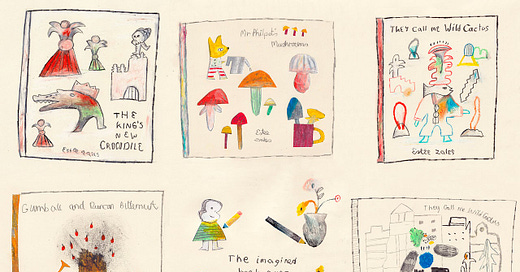


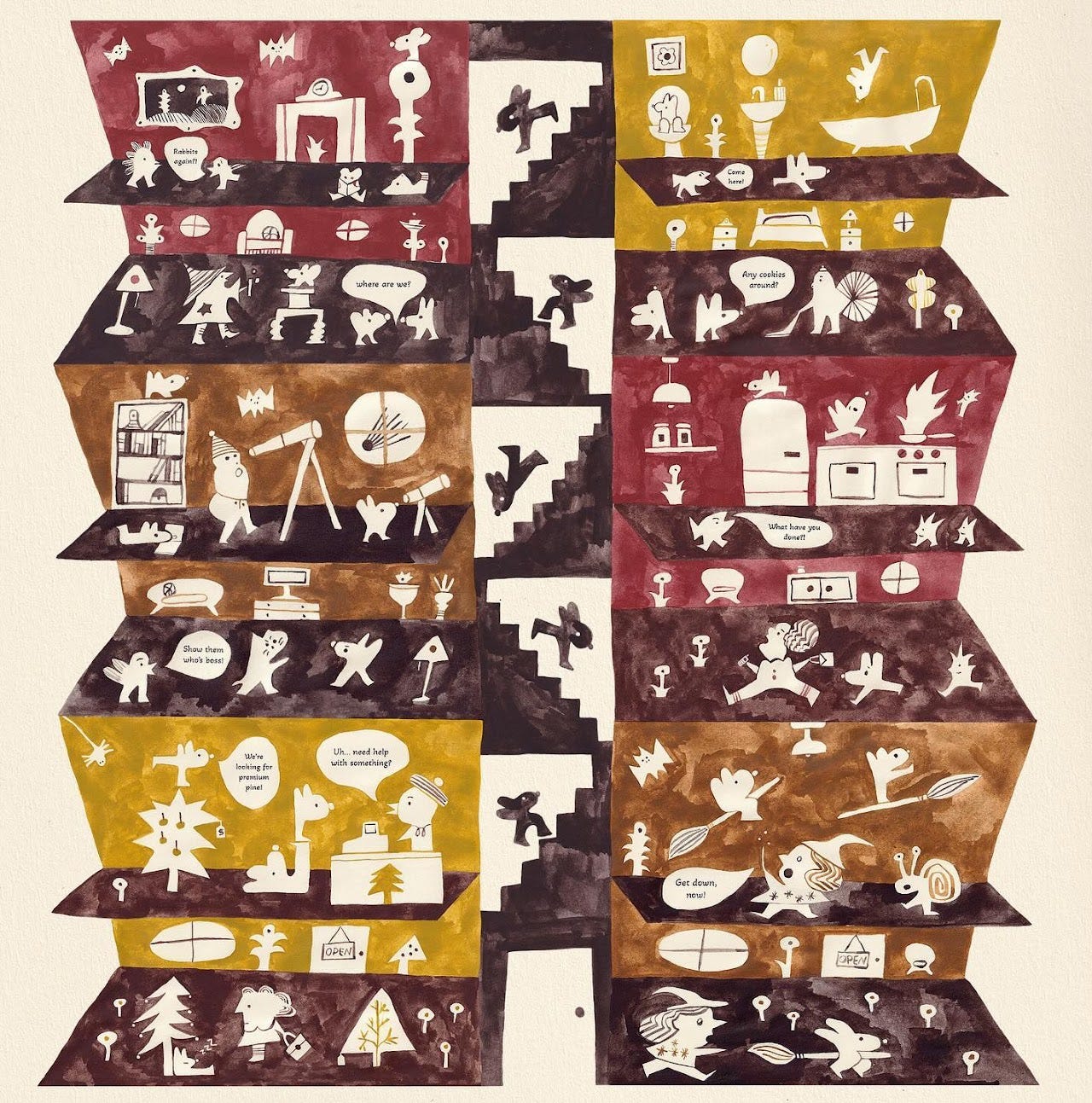

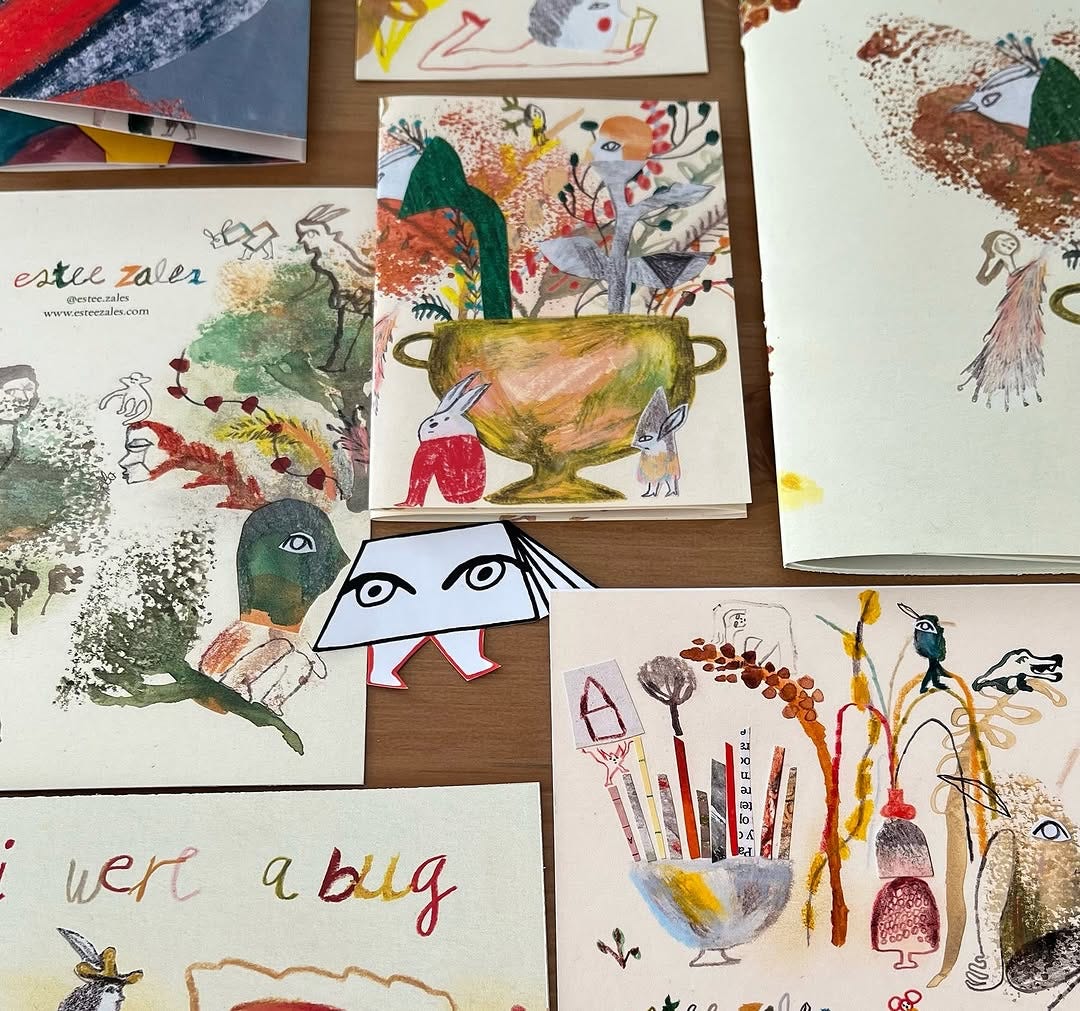
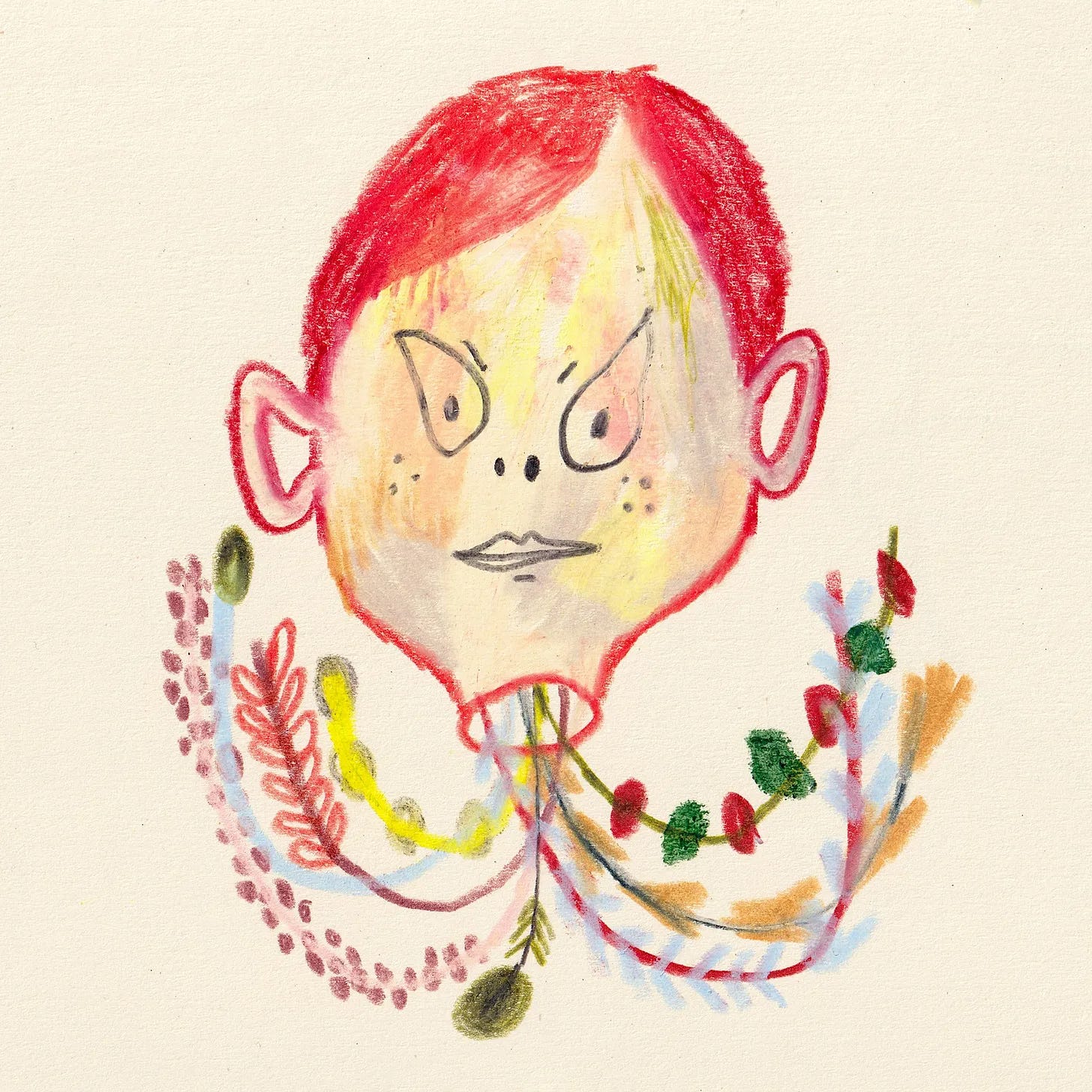
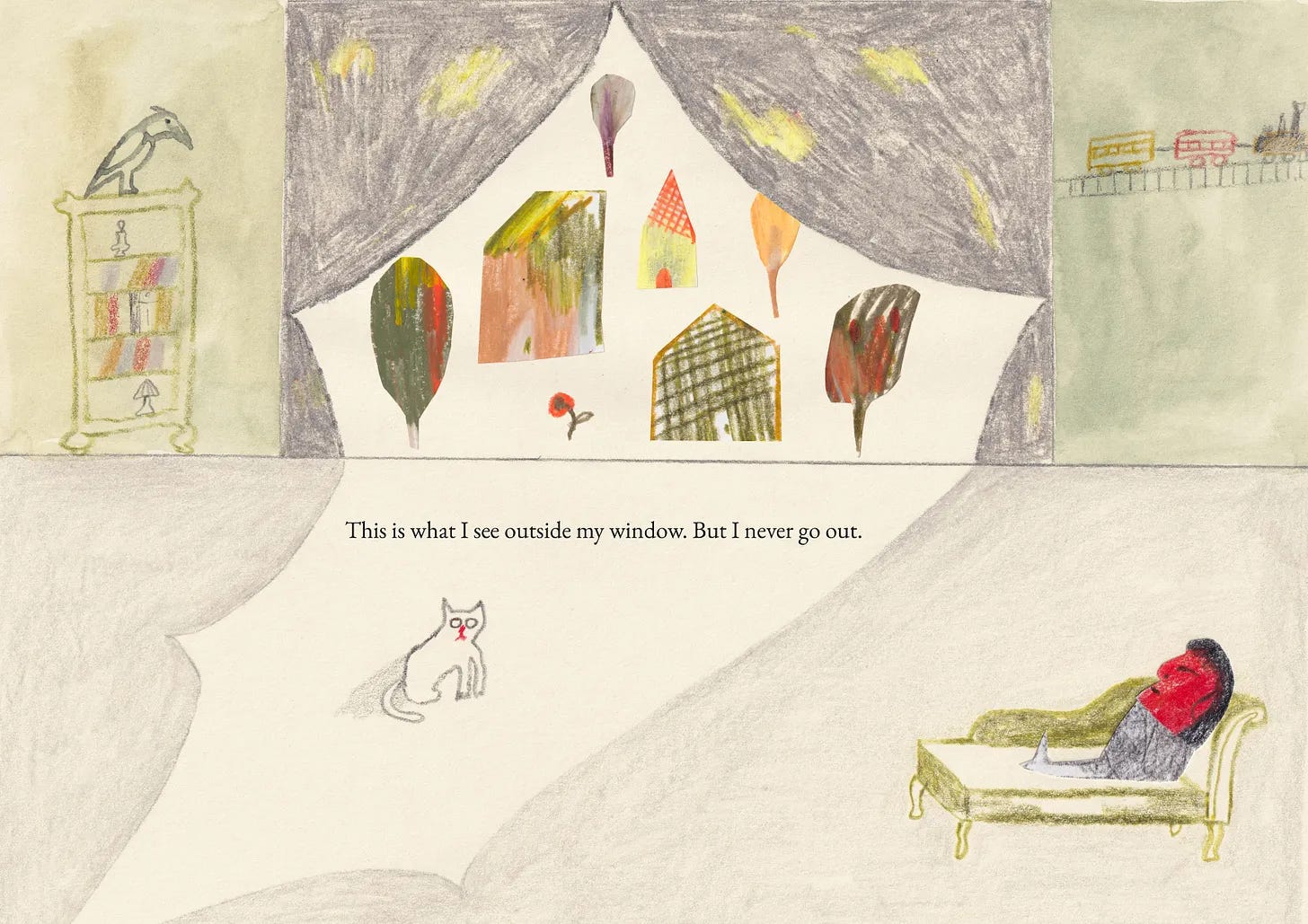

absolutely loved this, especially "I’m a human artist first, not a content machine." so very relatable.
It was a breath of fresh air to read the perspective of a working artist, I found so many things relatable and inspiring. Lovely post!